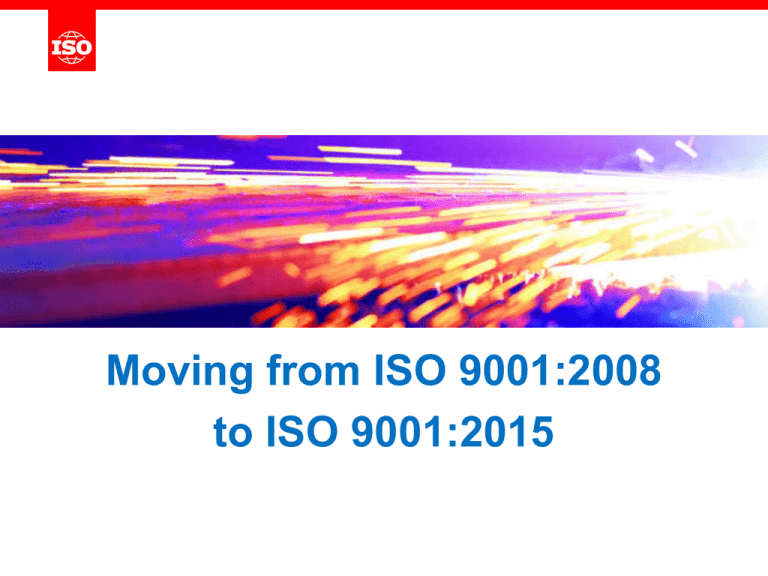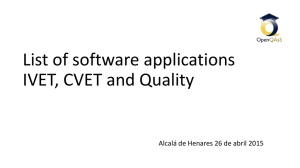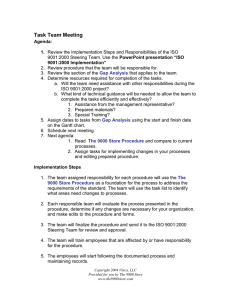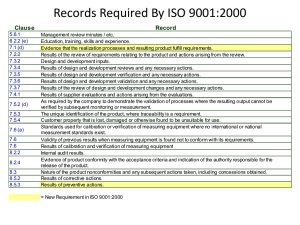
Moving from ISO 9001:2008
to ISO 9001:2015
What is ISO 9001?
ISO 9001 is a standard that sets out the requirements for
a quality management system. It helps businesses and
organizations to be more efficient and improve customer
satisfaction.
A new version of the standard, ISO 9001:2015, has just been
launched, replacing the previous version (ISO 9001:2008).
Who is ISO 9001 for?
• ISO 9001 is suitable for organizations of all types, sizes and sectors.
• In fact, one of the key improvements of the newly revised ISO
9001:2015 was to make it more applicable and accessible to all types
of enterprises.
• Smaller companies that do not have staff dedicated to quality can still
enjoy the benefits of implementing the standard – ISO has many
resources to assist them.
What benefits will it bring to my
business or organization?
Implementing a quality management system will help you:
•
Assess the overall context of your organization to define who is
affected by your work and what they expect from you. This will
enable you to clearly state your objectives and identify new
business opportunities.
•
Put your customers first, making sure you consistently meet their
needs and enhance their satisfaction. This can lead to repeat
custom, new clients and increased business for your organization.
ISO 9001: benefits
•
Work in a more efficient way as all your processes will be aligned
and understood by everyone in the business or organization. This
increases productivity and efficiency, bringing internal costs down.
•
Meet the necessary statutory and regulatory requirements.
•
Expand into new markets, as some sectors and clients require
ISO 9001 before doing business.
•
Identify and address the risks associated with your organization
Why was ISO 9001 revised?
• All ISO standards are reviewed and revised regularly to make sure
they remain relevant to the marketplace.
• ISO 9001 has been updated to take into account the different
challenges that businesses now face.
• For example, increased globalization has changed the way we do
business and organizations often operate more complex supply
chains, and there are increased expectations from customers.
• ISO 9001 needs to reflect these changes in order to remain relevant.
What are the key improvements?
Structure
ISO 9001:2015 now follows the same overall structure as other ISO
management system standards (High-Level Structure), making it easier
for anyone using multiple management systems.
See Annex SL of ISO/IEC Directives Part 1 (the rules for developing
ISO standards) for further information.
Focus on risk-based thinking
This has always been part of the standard, but the new version gives it
increased prominence.
More information can be found on the Website run by ISO/TC 176/SC
2, the group of experts behind the standard
(www.iso.org/tc176/sc2/public).
What benefits does the
new version bring?
The new version of the standard brings the user a number of benefits.
ISO 9001:2015:
• Puts greater emphasis on leadership engagement
•
Helps address organizational risks and opportunities in a
structured manner
•
Uses simplified language and a common structure and terms,
particularly helpful to organizations using multiple management
systems
•
Addresses supply chain management more effectively
•
Is more user-friendly for service and knowledge-based
organizations
I am currently using
ISO 9001:2008.
What should I do ?
As ISO 9001 has been revised to meet the needs of today’s business world, we
recommend that you update your quality management system to fit the new
version.
Here are some tips that will help you get started on the journey.
Tip 1 – Familiarize yourself with the new document. A correlation matrix,
available from ISO/TC 176/SC 2, will help you identify if parts of the standard
have been moved to other sections.
Tip 2 – Identify any organizational gaps which need to be addressed to meet the
new requirements.
Tip 3 – Develop an implementation plan.
Tip 4 – Provide appropriate training and awareness for all parties that have an
impact on the effectiveness of the organization.
Tip 5 – If you are certified to the standard, talk to your certification body
about transitioning to the new version.
I am certified
to ISO 9001:2008.
What should I do ?
• If you wish to maintain your certification to ISO 9001,
you will need to upgrade your quality management system to
the new edition of the standard and seek certification to it.
• You have a three-year transition period from the date of
publication (September 2015) to move to the 2015 version. This
means that, after the end of September 2018, a certificate to
ISO 9001:2008 will no longer be valid.
International Organization for Standardization
ISO Central Secretariat Chemin de Blandonnet 8 Case Postale 401
CH – 1214 Vernier, Geneva
Switzerland
iso.org
© ISO, 2015
All rights reserved ISBN 978-92-67-10648-9






